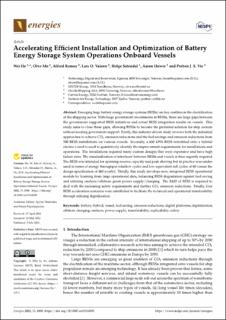| dc.contributor.author | He, Wei | |
| dc.contributor.author | Mo, Olve | |
| dc.contributor.author | Remøy, Alfred | |
| dc.contributor.author | Valøen, Lars Ole | |
| dc.contributor.author | Såtendal, Helge | |
| dc.contributor.author | Howie, Aaron | |
| dc.contributor.author | Vie, Preben Joakim Svela | |
| dc.date.accessioned | 2022-08-08T09:27:41Z | |
| dc.date.available | 2022-08-08T09:27:41Z | |
| dc.date.created | 2022-07-19T12:19:25Z | |
| dc.date.issued | 2022 | |
| dc.identifier.issn | 1996-1073 | |
| dc.identifier.uri | https://hdl.handle.net/11250/3010582 | |
| dc.description.abstract | Emerging large battery energy storage systems (BESSs) are key enablers in the electrification of the shipping sector. With huge government investments in BESSs, there are large gaps between the government supported BESS initiatives and actual BESS integration results on vessels. This study aims to close these gaps, allowing BESSs to become the preferred solution for ship owners without needing government support. Firstly, this industry-driven study reviews both the industrial approaches to achieve CO2 emission reductions and the fuel savings and emission reductions from 500 BESS installations on various vessels. Secondly, a 630 kWh BESS retrofitted onto a hybrid-electric vessel is used to quantitively identify the improvement requirements for installations and operations. The installations required many custom designs that were expensive and have high failure risks. The standardization of interfaces’ between BESSs and vessels is thus urgently required. The BESS was intended for spinning reserve capacity and peak shaving but in practice was under-used in terms of energy throughput (shallow cycles and low equivalent full cycles of 80 versus the design specification of 480 yearly). Thirdly, this study develops new, integrated BESS operational models by learning from large operational data, balancing BESS degradation against fuel saving and utilizing onshore/offshore green power supply/charging. The R&D of BESS is required to deal with the increasing safety requirements and further CO2 emission reductions. Finally, four BESS acceleration scenarios were established to facilitate the technical and operational transferability through utilizing digitalization | en_US |
| dc.language.iso | eng | en_US |
| dc.rights | Navngivelse 4.0 Internasjonal | * |
| dc.rights.uri | http://creativecommons.org/licenses/by/4.0/deed.no | * |
| dc.title | Accelerating Efficient Installation and Optimization of Battery Energy Storage System Operations Onboard Vessels | en_US |
| dc.title.alternative | Accelerating Efficient Installation and Optimization of Battery Energy Storage System Operations Onboard Vessels | en_US |
| dc.type | Peer reviewed | en_US |
| dc.type | Journal article | en_US |
| dc.description.version | publishedVersion | en_US |
| dc.rights.holder | © 2022 by the authors. | en_US |
| dc.source.volume | 15 | en_US |
| dc.source.journal | Energies | en_US |
| dc.source.issue | 13 | en_US |
| dc.identifier.doi | 10.3390/en15134908 | |
| dc.identifier.cristin | 2038769 | |
| dc.relation.project | Norges forskningsråd: 321559 | en_US |
| cristin.ispublished | true | |
| cristin.fulltext | original | |
| cristin.qualitycode | 1 | |

